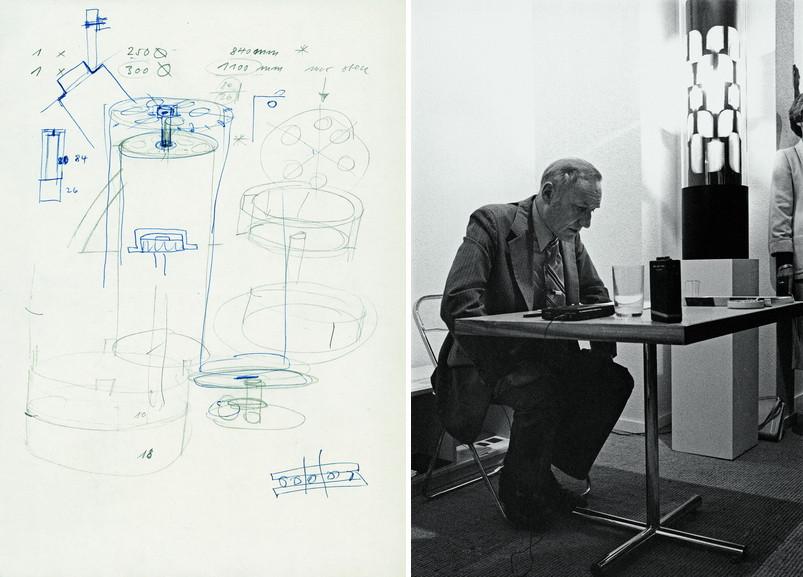The Story of William Burroughs, Brion Gysin, The Dreamachine and von Bartha
In 1970, a particular exhibition space opened in Basel. Galerie von Bartha was entirely focused on hosting and presenting radical artistic practices conducted by the proponents of Concrete and Kinetic art. Gradually, the gallery started representing various artists, and regardless of the art market tendencies it remained interested in the legacy of the historically significant movements, those which defied the representational canons.
Von Bartha organized other non-exhibition programs, and one of them seems especially important today. In 1979, the art dealer Carl Laszlo hosted the iconic writer William S. Burroughs and his peer, an important author himself, Brion Gysin. The invitation marked the twentieth anniversary of the publication of Burroughs’ legendary book Naked Lunch, which he read at the event, shocking the Basel society. At the same time, the two men found Miklos von Bartha, the gallery owner, who turned out to be the perfect individual to finally construct The Dreamachine with, a special kind of an optical device conceptualized by Gysin.
To revisit the iconic reading and the influence it made on the local art scene, and to unravel the dialog between the founding fathers of the Beat movement and the gallerist, Galerie Von Bartha is hosting a proper retrospective focused on the individual and mutual work by Gysin and Burroughs, including original construction plans and prototypes of The Dreamachine, archival photographs along with the works by other Beatniks.

An Encounter To Remember
Around the mid-1940s, William S. Burroughs met Jack Kerouac and Allen Ginsberg. In New York, gradually he became a drug addict and moved to Mexico where he wrote his first novel Junkie and shot his wife Joan Vollmer. Burroughs was convicted of homicide in absentia and was given a two-year suspended sentence. He then traveled through a few South American countries to explore a drug called yage for which he believed to provide the user telepathic abilities. Between 1958 and 1959, the writer wrote Naked Lunch while staying at the legendary Beat Hotel in Paris with his collaborator and friend Brion Gysin, who initially acted as a Surrealist painter until he opened a bar in Morocco and started writing.
It was in Tangier that William S. Burroughs got introduced by the cut-up technique invented by Gysin (who found it by accident in the Dadaist legacy), and that is how he developed Naked Lunch. Gysin emphasized their collaboration:
William Burroughs and I first went into techniques of writing, together, back in room No. 15 of the Beat Hotel during the cold Paris spring of 1958... Burroughs was more intent on Scotch-taping his photos together into one great continuum on the wall, where scenes faded and slipped into one another than occupied with editing the monster manuscript... Naked Lunch appeared and Burroughs disappeared. He kicked his habit with Apomorphine and flew off to London to see Dr. Dent, who had first turned him on to the cure. While cutting a mount for a drawing in room No. 15, I sliced through a pile of newspapers with my Stanley blade and thought of what I had said to Burroughs some six months earlier about the necessity for turning painters' techniques directly into writing. I picked up the raw words and began to piece together texts that later appeared as "First Cut-Ups" in Minutes to Go.

Brion Gysin and The Dreamachine
As a result of mutual admiration, in the early 1960s Brion Gysin designed the first Dreamachine, a flicker device aimed to expand the viewer’s perception, with the help of mathematician Ian Sommerville. This kinetic art object is an actual cylinder made of a perforated paper tube illuminated from the inside by light bulbs and placed on a turntable rotated at 78 or 45 revolutions per minute. The holes in the tube were produced according to a special pattern developed by Gysin.
The observer is exposed to Dreamachine at eye level with their eyes closed, and if the object is constructed properly, it emits light waves (between 8 and 13 Hz), electrical oscillations present in the human brain while relaxing. The observer experiences increasingly bright, complex patterns of color behind their closed eyelids (an effect similar when traveling as a passenger in a car or bus), while the patterns gradually appear as shapes and symbols in a swirl. And so, The Dreamachine achieves a sort of a hypnagogic state and aims to expand one's perception. Although the experience itself may be intense, one can stop it just by opening their eyes.

Burroughs and Gysin at Galerie von Bartha
For a few decades, Burroughs’ work was highly appreciated on the margin, until it was rediscovered by a new generation of practitioners during the 1960s. His writings became essential for the development of radical art practices of the seventh and eighth decade of the 20th century, along with Gysin’s notorious cut-up technique which was very often underlined as a crucial invention for the development of art of the second half of the 20th century.
Looking from the contemporary stance, The Dreamachine was the result of the constant exchange of the two artists who shared an interest in the marginal, the obscene, the occult and the otherworldly. The way they searched to overcome the limitations of the human mind, and revolutionize the thinking process and therefore the society, makes Burroughs and Gysin unprecedented figures in a broader context of culture and humanities.
William S. Burroughs & Brion Gysin – The Dreamachine will be on display at Galerie von Bartha in Basel from 16 November 2019 until 1 February 2020.
Featured image: Brion Gysin and William S. Burroughs with the Dreamachine. Photo by Christoph Markwalder. All images courtesy Galerie Von Bartha.
Can We Help?
Have a question or a technical issue? Want to learn more about our services to art dealers? Let us know and you'll hear from us within the next 24 hours.
